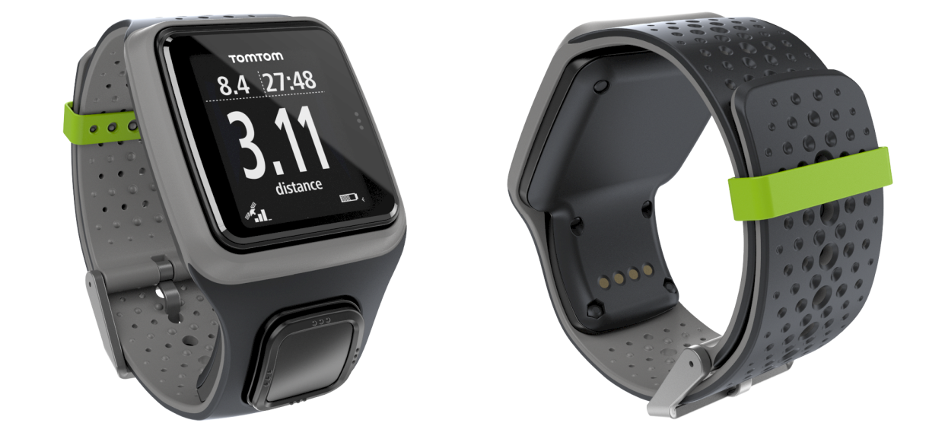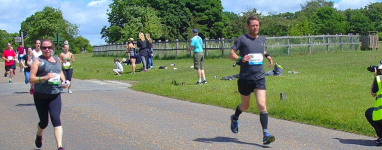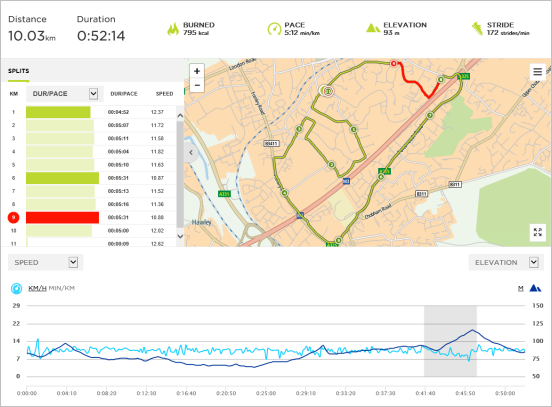Those of you who are my Facebook friends will know that I’ve lost a lot of weight over the past year, and converted myself from a couch potato to someone who runs 10 km a few times a week. I recently entered my first 10 km race and was placed 37th out of 76. I say “race” but I had no expectation of winning. And only 73 finished (according to the competitor tracking web site, two of the runners are still out there somewhere). I finished the run around Dorney Lake (two laps) in 56 minutes 11 seconds – a month before I was hoping for better, but three weeks before the race I strained my left Achilles tendon. I couldn’t train for nearly three weeks, and it was only after completing 5 km comfortably two days before the race that I decided to run on the day.
This moderate success made me think a little more about the actual distances I was running and the times – I was basing distances on Bing maps and times on my ‘gym watch’ which features nothing more sophisticated than two hands. So I installed Caledos Runner on my Windows Phone and put it in the pocket of my running jacket. This worked fine, although the phone was a bit bouncy in the pocket – but it provided timing and distance, and one of those little route maps that us running bores post on Facebook.
Then the weather warmed up a bit, and that jacket wasn’t suitable attire. I tried the arm-band that came with the Plantronics Backbeat Fit headphones, but didn’t really like having that around my upper arm. There was only one choice left – a GPS watch.
Let me now bore you with the thought process. I have a Fitbit Flex (actually I now have a Fitbit Charge, but we’ll leave that for another day) so an obvious choice could have been upgrading to Fitbit’s watch, the Surge – that would do the job of fitness tracker and watch (a running watch with GPS) all in one. However, I didn’t want something to replace my collection of ‘real’ watches which I like wearing. And it seemed a bit daft to wear a watch on each wrist. Oh, and I didn’t see the need for a heart monitor.
A standard GPS watch, one which I would only use for running, was my preferred option. Loads to choose from on the market but £100 seemed like a reasonable price and for that there were two seemingly-unrivalled choices… Garmin’s Forerunner 15 and TomTom’s Runner. Lots of people recommended the Garmin watch, but after trying out and inspecting both of them I went with the TomTom, basically because it looked a bit better and was less chunky (and I was later to discover that you can easily clip on a replacement strap of another colour).

In the box – the watch, a USB cradle and a small instruction manual. After connecting the watch to the PC via USB, the TomTom MySports sync software was installed and an account was set up. The set-up of the watch itself was very simple – age, weight, height and gender, and an option to change the display units on-screen. There are other settings, none of which I’ve used, which alert you to maintaining a desired pace or running a certain distance (e.g. buzzing every 2 km).
On the first run the watch was very quick to pick up a GPS signal – when it’s cloudy it can take up to a couple of minutes, but that just gives me a chance to hop on the spot and warm up a bit. Operation of the watch is very simple, a couple of presses on the control button to start running, a press in the other direction to pause (pausing is for pussies) and a second press to end the run. Attaching the watch to the cradle uploads the data to the MySports web site, which provides a map of the route and times for each kilometer (or mile, depending on the units you’ve set). And an added bonus which I didn’t know about… it shows the elevation of the route. Easy to pick out that nasty Church Hill or that long steady climb up the A30.
Click on the image below to see the larger version.
I then discovered that the TomTom MySports site doesn’t allow you to share the route map on Facebook – but there is an option to automatically save the GPS data in two standard formats (GCX and TCX), and these files can be uploaded into running sites such as Runtastic, and can then be shared on Facebook.


